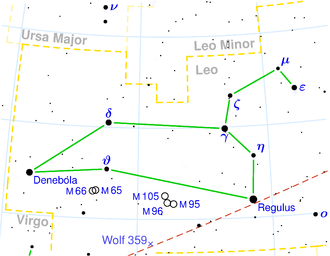NGC 3869
| Galaxy NGC 3869 |
|
|---|---|

|
|
| SDSS recording | |
| AladinLite | |
| Constellation | lion |
|
Position equinox : J2000.0 , epoch : J2000.0 |
|
| Right ascension | 11 h 45 m 45.5 s |
| declination | + 10 ° 49 ′ 29 ″ |
| Appearance | |
| Morphological type | Sat |
| Brightness (visual) | 12.7 mag |
| Brightness (B-band) | 13.6 mag |
| Angular expansion | 1.9 ′ × 0.5 ′ |
| Position angle | 135 ° |
| Surface brightness | 12.5 mag / arcmin² |
| Physical data | |
| Redshift | 0.010150 ± 0.000143 |
| Radial velocity | (3043 ± 43) km / s |
|
Stroke distance v rad / H 0 |
(132 ± 9) x 10 6 ly (40.6 ± 2.9) Mpc |
| history | |
| discovery | John Herschel |
| Discovery date | May 10, 1826 |
| Catalog names | |
| NGC 3869 • UGC 6737 • PGC 36669 • CGCG 068-059 • MCG + 02-30-032 • 2MASX J11454556 + 1049286 • GC 2538 • h 971 • LDCE 0836 NED033 | |
NGC 3869 is a spiral galaxy from the Hubble type Sa in Leo on the ecliptic . It is estimated to be 132 million light years from the Milky Way .
The object was discovered by John Herschel on May 10, 1826 .
